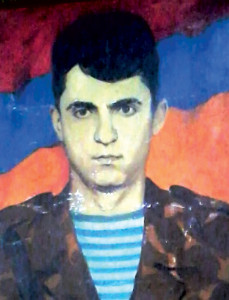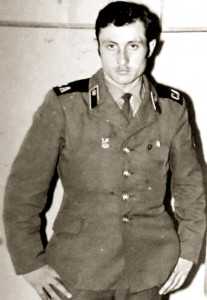FROM PITCHFORKS TO DRONES…
 When in mid-July our heroic soldiers and officers bravely resisted another provocation of Azerbaijan, this time on the border settlements and military units of the Republic of Armenia, I, unlike many friends and relatives, had no doubt that the Turks would suffer another defeat and retreat. Where does that belief come from?
When in mid-July our heroic soldiers and officers bravely resisted another provocation of Azerbaijan, this time on the border settlements and military units of the Republic of Armenia, I, unlike many friends and relatives, had no doubt that the Turks would suffer another defeat and retreat. Where does that belief come from?
It was 1991. With insane plans to recapture liberated Artsakh, the Azeris launched a large-scale attack on the border settlements of Armenia and Artsakh. It was the last days of autumn. My brother-in-law Edik called from Irkutsk, Russia, where he was doing business. He said he heard that the Turks had attacked our village? Well, what can we do? I tried to calm down, barely restraining myself from saying that his father’s two-story house was razed to the ground by the Turkish bombing. “I have already bought a ticket to fly to Moscow, I will call from Moscow, please meet me.” In the past, when Edik came to Armenia, he did not bother me. He took a taxi from the airport and went straight to the village or came to our house, but he knew very well that there was a curfew in Armenia and tanks had closed the streets. Fortunately, the license plates of certain cars were kept on my official Volga, and my driver was able to enter the streets of Yerevan freely. Early in the morning, Edik called from Moscow and waited to be at the airport at 12 o’clock. Edik was not alone. His close friend Yura came with him. He had fought in Afghanistan and said his experience in Armenia would be very useful. As Edik asked to be taken directly to their village, Nerkin Karmiraghbyur in the Shamshadin region at that time, we had a light lunch at the airport and left. I will not describe how Edik accepted the ruin of a magnificent house where he spent his childhood and youth. Shortly afterwards, his cousin Yeghishe came to apologize for being late. When he said that he had come to take food to the boys on duty, Edik said without hesitation that I would come too. When he translated Yura for something, he also expressed his willingness to come. After a light meal, I asked the driver to inform me at work that I would not be at work for a few days, and as he said goodbye, I joined the boys.
Nerkin Karmiraghbyur borders the Azerbaijani village of Alibeyli. Until recently, Azeris brought watermelons on donkeys, sold them in the village and spent the night in the house of their Armenian ‘yoldash’, were generously entertained, and gave speeches of friendship with selected mulberry vodka. From the first days of the war, the Azerbaijani OMON fighters had flooded the border villages, many of the ‘yoldash’ of yesterday were given machine guns. Our positions were on the bank of the Tavush “river” flowing under the village. It is a shame to call it a river, to put it mildly, because even during spring floods you can walk from one shore to another, wetting only the part of the body up to the knees. And so, on this side of the river were our positions, a few meters away, the Azeris. Unlike the Azeris armed with Kalashnikov assault rifles and grenades (they looted Soviet army ammunition from long-distance arsenals, bought weapons from Soviet officers), our main ‘weapons’ were pitchforks and shovels, and some acquired hunting rifles left in the village. We were on duty with 10-12 people. There were so many reservists in the village, they were resting and waiting for the alarm to come to the rescue if needed… There were few clashes.
 In January-February 1992, when the Artsakh freedom fighters occupied the villages of Krkjan and Khojalu, which were heavily shelled by Stepanakert, the furious Azeris began to become active not only in Artsakh, but also in the territories bordering Armenia and Armenia. Since the Armenian army had already been formed, we turned to Col Vazgen Ghavalyan, a former freedom fighter who coordinated the fighting in the area and was already the commander of the military unit, with a request to give us several rifles. Two days later we already had rifles. In the same days, tanks and Grad were on the Azerbaijani side. In the first days of April, the former ‘Yoldash’ started firing on our positions. Seeing that we were not the ones who fired the least, they shelled the village houses, the school and the kindergarten. We informed Ghavalyan about the situation by radio. An hour later, a tank arrived from Berd. Seeing the tank, the Azeris fled in panic.
In January-February 1992, when the Artsakh freedom fighters occupied the villages of Krkjan and Khojalu, which were heavily shelled by Stepanakert, the furious Azeris began to become active not only in Artsakh, but also in the territories bordering Armenia and Armenia. Since the Armenian army had already been formed, we turned to Col Vazgen Ghavalyan, a former freedom fighter who coordinated the fighting in the area and was already the commander of the military unit, with a request to give us several rifles. Two days later we already had rifles. In the same days, tanks and Grad were on the Azerbaijani side. In the first days of April, the former ‘Yoldash’ started firing on our positions. Seeing that we were not the ones who fired the least, they shelled the village houses, the school and the kindergarten. We informed Ghavalyan about the situation by radio. An hour later, a tank arrived from Berd. Seeing the tank, the Azeris fled in panic.
The ‘yoldash’ were silent for two days. On April 6, the Azeris again shelled the village and tried to cross the river to enter the village. Our tank, Alazan and Grad, also started working. We were shooting with a grenade launcher. Suddenly, one of the grenades thrown by the ‘Yoldash’ exploded in our position. It killed Edik. …
… We buried Edik in the village cemetery.
By ASKANAZ ABRAHAMYAN
Military historian
Category: #31 (1351) 05.08.2020 - 11.08.2020, Destinies, Spotlight, Pages of History










